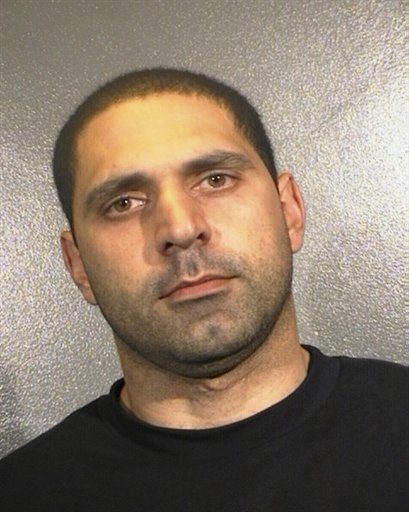Kathlene M. writes:
Today in the print edition of USA Today, there was a story about the serial killer manhunt called “Serial Killer Puts City on Edge” with the subtitle,
“Pure hatred” driving attacks that may be across 3 states
The composite sketch shows a white man wearing a baseball cap. And the opening line of the article states:
“College student Felipe Andrez, 21, says he “walks more aggressively” to deter the white man in a baseball cap who police say asks his male victims for assistance or directions before stabbing them.”

White man in baseball cap
Further in the article, we read more:
“Because 14 of the victims here were black, some people believe the slasher is driven by racial animosity. ”
“I believe (the killer’s) motivation is pure hatred,” Leesburg Police Chief Joseph Price said Tuesday. The three victims there are minorities.”
In an impromptu conversation on campus, sociology student Malcolm Banks, 37, pitches [Professor Larry] Koch some questions about the killer: Could he be a former member of the military who was passed over for promotion by a black man?”
“Plenty of people here have theories. … “Maybe he got ripped off by a black guy,” says Rich McDowell, 50, a handyman.”
“It’s a different story for Abhishek Utekar, 28, who arrived here last week from India, to study health care management. He avoids eye contact with white men and plans to buy a whistle to alert passersby if he’s attacked.”
In case the link no longer works, I’ve copied the text of the article below.
However, today the serial killer suspect was caught. His name is Elias Abuelazam (see photo also attached to this email) who is an Israeli citizen. [LA replies: the middle name “Abu” shows that he is a Muslim.] Hardly the evil racist redneck white American we were all expecting. So now that the killer is not the tea partier we were expecting, but an Israeli citizen, I wonder if the hate crime/racial angle of this story will be dropped.
First article’s text is below:
By Judy Keen, USA TODAY
August 12, 2010
FLINT, Mich.—College student Felipe Andrez, 21, says he “walks more aggressively” to deter the white man in a baseball cap who police say asks his male victims for assistance or directions before stabbing them.
Colette Graham, 40, told her uncles to call her for a ride instead of walking alone at night.
Christina Carter, 35, keeps her five children indoors and sizes up every man in a green SUV that looks like the one police say the serial killer drives. “This is not a game,” Carter says. “It’s really a sad situation” in a city beset by more than 150 arson fires this spring and an unemployment rate of 14.1%.
Law enforcement officials believe the killer has attacked 20 men. The first 16 stabbings were in or near this city of 111,475, the birthplace of General Motors. Five victims died. Police in Leesburg, Va., are investigating three similar attacks there last week. Police say a stabbing Saturday in Toledo might be related.
Because 14 of the victims here were black, some people believe the slasher is driven by racial animosity. Harry Williams, 52, who works at GM and is black, says that when strangers approach, “I don’t let them get too close.” When he spots someone who fits the killer’s profile, “I’m watching them all the time.”
“I believe (the killer’s) motivation is pure hatred,” Leesburg Police Chief Joseph Price said Tuesday. The three victims there are minorities.
The suspect is muscular, in his late 20s or early 30s, weighs 180-210 pounds and has light-colored hair, police say. All victims were attacked after midnight while they were walking alone. A task force of 40 investigators, including the FBI, has received 469 tips, some “very encouraging,” Genesee County Prosecutor David Leyton said.
Leyton says that although there might be “some racial component” to the killings, the suspect said nothing indicating a racial motive to surviving victims.
The first attack was May 24, but Leyton says investigators didn’t see a pattern until late July because the first two victims died and some survivors didn’t immediately report the attacks.
Frances Gilcreast, president of Flint’s NAACP chapter, wishes authorities had alerted the community sooner that a serial killer was on the loose. “We have been plagued with hard times in this community,” she says. “We felt we were taken for granted as far as notifying us” about the threat.
Attacker is ‘an anomaly’
Larry Koch, 64, who teaches criminal justice at the University of Michigan-Flint, says it’s impossible to know the man’s motives until he is caught. Serial killing, he says, “is not a social issue; it’s a personal problem.”
In an impromptu conversation on campus, sociology student Malcolm Banks, 37, pitches Koch some questions about the killer: Could he be a former member of the military who was passed over for promotion by a black man? Why does he use a knife instead of a gun?
“Who knows?” the professor says. “This is a crazy thing that happens in the world.”
History suggests that serial killers have a few things in common, Koch says: They don’t kill people they know, and they were raised in violent surroundings. “What we’re talking about here is an anomaly,” he says.
Plenty of people here have theories. “To do this, somebody’s got to be mentally sick,” says Amanda Slater, 20. “Maybe he got ripped off by a black guy,” says Rich McDowell, 50, a handyman.
Leyton says, “There’s a raging fire emerging” in the killer, whom he describes as “pure evil” and “clearly deranged.”
He says investigators don’t know whether the suspect is still in the Flint area.
Men have been sole target
Because the killer has attacked only men, women feel less vulnerable—but they worry about the men in their lives.
Retiree Karma Common, 52, doesn’t fret about her own safety, but she asked her 22-year-old son “to be extra vigilant.”
Crystal Dillard, 24, a social sciences student, says she doesn’t feel wary anywhere. “I don’t, being a white female,” she says.
It’s a different story for Abhishek Utekar, 28, who arrived here last week from India, to study health care management. He avoids eye contact with white men and plans to buy a whistle to alert passersby if he’s attacked.
Law school student Carey Lee, 31, got some odd glances from people after the killer’s description first circulated. He thought he sort of fit the profile until police added that the suspect has an ear piercing. “People were more cautious around me,” he says.
Now he’s trying to answer the question many people here are asking: Why would someone do this? Lee thinks “the way he’s been hunting people” is a clue. “Was he asking for help sometime and got attacked himself?”
Olivia Bassett, 19, a babysitter, speaks for many when she says, “It is just crazy that this could happen here.”
Kathelene M. writes:

